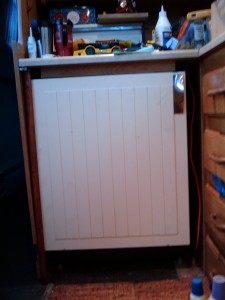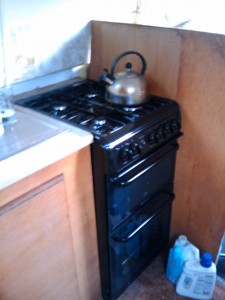We had another working weekend on the boat this last weekend and we were tackling two pretty big projects:
1) Replacing the gas cooker
2) Replacing the fridge.
We had found a very good LPG cooker on line which has flame failure devices on all burners and an electric ignition driven from a battery. Its an Electrolux and has four burners with a tiny little “simmer” one and a rather large burner and two nice sized ones. Its not a “boat” cooker but it meets ALL the requirements of the BSS and we did find that the “Official” recommendations for the ventilation for fitting it in a house/flat are less stringent than the BSS for fitting it in a boat. For example they assume that if you don’t have a lot of fixed ventilation then you’ll simply open a window. Whereas the BSS just assumes that you are so stupid that you’ll suffocate to death before opening the window!
The fridge is an under counter fitted style one which we got hold of second hand. Its made by Whirlpool and is supposedly an A rated fridge.We’d taken the fridge up previous to do some tests and we were happy that it would work so we were going to fit it.
The proposed plan of action was:
1) Remove old gas fridge
2) Remove front of cupboard round old fridge space
3) Put new fridge into space and fix it in place
4) Remove old gas cooker
5) Move boat off mooring to unload old cooker and fridge and to load new cooker. We have to move the boat because the jetty isn’t as long as the boat and due to a design mistake when the boat was being fitted out you can’t get large objects through a dog leg round the bathroom. So anything big has to go in and out through the front door, so we needed to move the boat.
6) Install new cooker
7) Replace T in gas line where the fridge was tapped off it with a through connector.
It sounds simple but it all went wrong at stage 2 as the gas line to the old fridge went through a wooden partition that we needed to remove to put the new fridge in. So we had to turn the gas off and remove the gas line to the fridge. It was at this point that we found that the through connector was shorter than the T piece which meant we would have to move the whole gas line from the cooker backwards.
So we started doing work in parallel. I worked on the fridge and Nick removed all the clips that hold the gas line in place so we could move it back. We checked the new cooker and found that we would need a fitting that we didn’t have so we drove down to Norbury junction and picked up the fitting and grabbed a coffee as it was going to be quite a while before we could have another warm drink on the boat.
The new cooker has two gas feeds, one at either side of the cooker and in the instructions it recommends that the flexi pipe to the cooker does not cross the back of it. This was actually good news as it meant we could move the gas line backwards, giving us the spare we needed to take out the T junction and it also moved the stop valve and the bubble test point into a much more accessible position.
So now with both the old appliances disconnected we moved the boat over onto the public moorings on the other side of the canal and Nick walked along the path to the town centre (marked as Disabled friendly and thus ideal for running a sack trolley, with a cooker on it, along) and I went back to the mooring, collected the car and drove back to meet him.
We brought the new cooker to the boat and then took the old cooker and fridge to the car and then I drove the car back to the moorings.
We now had everything ready to go and apart from having to cut some of the old work surface away behind the cooker slot as the new cooker is deeper than the old one, everything went pretty well, apart from a few gas leaks but we sorted those out pretty quickly.
There is still some tidying up work to be done, in that we need new splash backs round the cooker and the fridge needs some trim putting round it but those are things we can do in the evenings if we want.


Its going to take a little getting used to the new cooker and the flame failure devices but it boils a kettle really quickly on the big burner and we’re going to have to play a bit with the fridge as it had semi frozen the sausages by Sunday morning.
We’re going to have to spend a bit of time playing with the fridge and how we use it. Its going to be running off the inverter which is not a problem during the day when the engine is running but its how much power it will take in the evenings when the engine is off that is the big concern. We’re going to get a thermometer with an alarm on it so we can monitor how quickly the fridge warms up when the power is off, and if we need to buy a second battery for the domestic power then we have to buy one, its not a problem as we have space for a second one.
On Sunday we did a general tidy up and then found the bilge pump had died so we’ve had to drop in a temporary replacement.
So things are progressing

Hi,
Interesting blog. Suggest the use of an inverter for a fridge isn’t the best idea. Inverters use power when on standby – and to run a fridge the inverter will have to be on for 24hrs.
This will substantially push up your power consumption. “Second” battery for the domestic system ? Phew… with a fridge and inverter etc – you need a decent bank of batteries – not just one or two.
Most livaboards boats need between 300ah and 1000ah per person (@12v) – in our experience (of supplying power systems for boats).
Inverters are fine for occasional use, however not good for prolonged use.
Happy cruising,
G.
Oddly enough the inverter seems to cope quite well and with only one battery (because we used to have two which failed and we dropped a single one in as a short term fix about 5 years ago) the fridge can happily run for 6 or more hours after we’ve shut the engine off without it causing any real problems.
We’re not a live aboard and have plans for a revamped battery setup with a dedicated battery for the inverter, for later in the year, after we’ve replaced the back deck and after I’ve found a new job.
Hi,
we are having problems sourcing a new cooker with 12v igniton. Could you state the model type and supplier?
We are after a stand alone. Most models are now with 240v ignition and I don’t want to go down the road of a rewire just for the cooker.
I have gas and water supplied down one side of the boat and 240v down the other and may never the twain shall meet!
Regards
John
Sure, Its an Electrolux and we bought it from Mark’s Electrical. http://markselectrical.co.uk/HW170LIK.html Its got full flame failure on all burners and the grill and the oven and the main burner is pretty hot. It uses a single AA for the ignition which is in a little enclosure at the bottom left front of the cooker, so its no problem to get at it.
Hi,
Interesting blog. Suggest the use of an inverter for a fridge isn’t the best idea. Inverters use power when on standby – and to run a fridge the inverter will have to be on for 24hrs.
This will substantially push up your power consumption. “Second” battery for the domestic system ? Phew… with a fridge and inverter etc – you need a decent bank of batteries – not just one or two.
Most livaboards boats need between 300ah and 1000ah per person (@12v) – in our experience (of supplying power systems for boats).
Inverters are fine for occasional use, however not good for prolonged use.
Happy cruising,
G.
Oddly enough the existing battery runs the inverter/fridge for about 6 hours after we shut the engine down and it only cuts out because the terminal voltage drops far enough for the inverter to trip out.
As its over 18 months since I posted that post and we’ve had no real problems at all I’m quite happy with the setup we’ve had.
BTW – just how many narrow boats have you supplied power systems for?
Pingback: We Got The Power | Scribblings from the Mintball